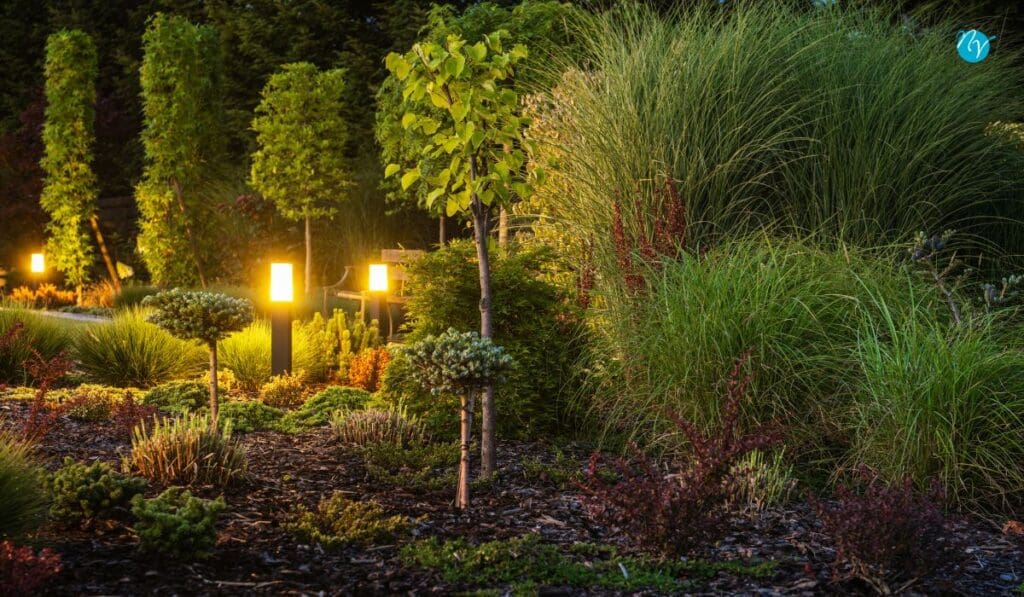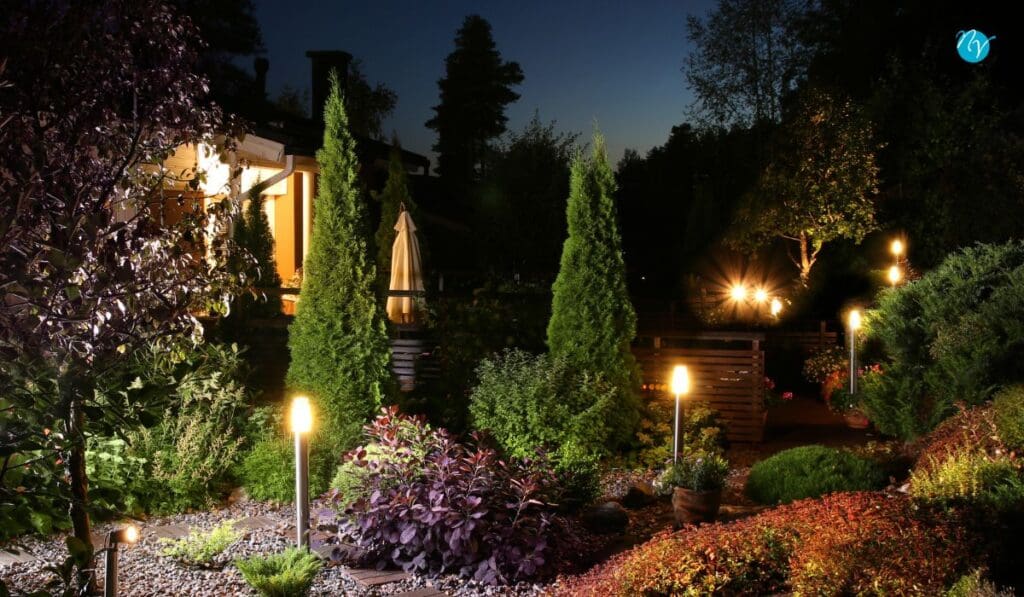Landscape lighting is an intricate blend of functionality and artistry that goes beyond merely illuminating outdoor spaces.
It’s about transforming your home into a captivating haven, creating an enchanting atmosphere that extends well into the night.
In this comprehensive guide, we will explore ten detailed and visually appealing places to install landscape lighting around your home.
Landscape Lighting
Landscape lighting is a carefully curated lighting design that involves strategically placing fixtures to highlight and accentuate the natural features and architectural elements of your outdoor space.
It aims to create a harmonious blend of aesthetics, functionality, and safety.
Importance of Landscape Lighting
The significance of landscape lighting extends beyond its visual appeal.
It serves as a practical solution to enhance safety by providing well-lit pathways and entrance areas.
Additionally, it contributes to the overall security of your property by deterring potential intruders.
Moreover, landscape lighting extends the usability of your outdoor spaces, allowing you to enjoy the beauty of your surroundings even after the sun sets.
Front Yard Lighting
Pathway Illumination
When considering landscape lighting for your front yard, start with illuminating pathways.
Low-voltage fixtures strategically placed along walkways not only enhance safety but also create a warm and inviting atmosphere.
Accentuating Garden Features
Elevate the visual appeal of your front yard by highlighting garden features such as ornamental plants, sculptures, or water features.
Well-placed lights draw attention to these elements, adding a touch of elegance to your landscaping.
Highlighting Entryways
Illuminate your front door and porch area to make a lasting impression.
Soft and welcoming lighting not only adds to the aesthetics but also ensures a well-lit entryway for residents and guests.
Backyard Oasis
Patio and Deck Lighting
Extend the functionality of your outdoor living spaces by incorporating lighting into your patio and deck areas.
Subtle, ambient lighting can transform these spaces into cozy retreats for evening relaxation and entertainment.
Pool and Water Feature Illumination
Make your backyard pool or water features a visual delight by installing underwater lights.
This not only enhances the beauty of the water elements but also adds a touch of magic to your outdoor oasis.
Tree Uplighting
For a dramatic effect, consider uplighting mature trees in your backyard.

This technique involves placing lights at the base of trees, casting enchanting shadows on branches and foliage.
Driveway and Entrance
Welcoming Entrance Lighting
Create a welcoming atmosphere by illuminating your driveway entrance.
This not only adds a touch of grandeur but also ensures a well-lit and safe entry for vehicles and pedestrians alike.
Security Enhancement with Driveway Lights
Boost the security of your property by strategically placing lights along the driveway.
This not only deters potential intruders but also provides added visibility for residents returning home after dark.
Garden and Plant Beds
Flower Bed Illumination
Bring your garden to life during the night by installing lights within flower beds.
This not only showcases the vibrant colors of your flowers but also adds depth and texture to your outdoor space.
Creative Plant Spotlights
Experiment with spotlighting specific plants or shrubs.
This creative approach not only adds visual interest but also allows you to showcase your favorite botanical elements in a unique way.
Outdoor Structures
Shed and Garage Lighting
Ensure every corner of your property is well-lit by installing lights around sheds and garages.
This not only enhances functionality but also contributes to the overall safety and security of your outdoor spaces.
Illuminating Pergolas and Gazebos
Extend the usability of your outdoor structures by incorporating subtle lighting.
This not only adds to the ambiance but also creates intimate and inviting spaces for evening gatherings.
Energy-Efficient Options
LED Lighting Benefits
Consider the numerous benefits of LED lighting for your landscape.
LED lights are energy-efficient, providing cost savings on electricity bills, and they offer a long lifespan, ensuring your outdoor lighting remains vibrant for years.
Solar-Powered Landscape Lights
Embrace eco-friendly options by opting for solar-powered landscape lights.
These lights harness energy from the sun during the day, providing illumination at night without adding to your electricity consumption.
DIY Installation Tips
Choosing the Right Fixtures
Selecting the right fixtures is crucial to the success of your landscape lighting project.
Consider the style of your home, the intended purpose of the lighting, and the durability of the fixtures in outdoor conditions.
Proper Wiring and Safety Measures
Prioritize safety during the installation process.

Follow proper wiring practices, adhere to manufacturer guidelines, and consider consulting with a professional for complex setups to ensure a secure and reliable lighting system.
Maintenance and Longevity
Cleaning and Inspection
Regular maintenance is key to ensuring the longevity and optimal performance of your landscape lighting.
Periodically clean fixtures, remove debris, and inspect for any signs of wear or damage.
Upgrading and Replacing
Stay abreast of technological advancements and design trends by periodically upgrading your fixtures.
This not only ensures your lighting remains contemporary but also enhances the overall aesthetic appeal of your outdoor space.
Conclusion
In conclusion, landscape lighting is a transformative element that can turn your home into a captivating masterpiece after sunset.
From the front yard to the backyard oasis, each area provides unique opportunities to enhance aesthetics, security, and functionality.
By strategically placing lights in these ten areas, you can create a visually stunning and inviting outdoor environment that truly comes to life in the evening.
FAQs
What are the benefits of using LED landscape lighting?
LED landscape lighting offers a plethora of benefits. Firstly, LEDs are highly energy-efficient, consuming significantly less power than traditional incandescent bulbs. This not only helps in reducing electricity bills but also contributes to a lower carbon footprint. Additionally, LED lights have an impressively long lifespan, lasting much longer than traditional bulbs. Their durability and resistance to shock and vibrations make them ideal for outdoor use, ensuring that your landscape lighting remains vibrant for an extended period. Lastly, LED lights provide bright and focused illumination, allowing you to highlight specific features in your outdoor space effectively.
Can I install landscape lighting myself?
Yes, many landscape lighting installations are suitable for a DIY approach. However, the level of complexity varies based on the design and features you desire. Simple installations, such as placing solar-powered lights along pathways, are generally manageable for homeowners. However, for more intricate setups involving electrical wiring, it’s advisable to consult with a professional. They can ensure proper installation, adherence to safety codes, and provide guidance on selecting the right fixtures for your specific needs.
How do I choose the right fixtures for my landscape lighting?
Selecting the right fixtures is crucial to the success of your landscape lighting project. Consider the style of your home and outdoor space, as well as the intended purpose of the lighting. Different fixtures serve different purposes, such as floodlights for broad illumination, spotlights for accentuating specific features, and pathway lights for guiding routes. Additionally, opt for fixtures that are durable and suitable for outdoor use to withstand varying weather conditions and ensure longevity.
Are solar-powered landscape lights effective in all weather conditions?
Solar-powered landscape lights are generally effective in various weather conditions, but their performance may be influenced by sunlight availability. In areas with consistent sunlight, solar lights can charge efficiently, providing reliable illumination. However, in regions with frequent overcast days or limited sunlight, the effectiveness of solar-powered lights may be reduced. It’s essential to place solar lights in areas that receive an adequate amount of sunlight for optimal charging.
How often should I inspect and maintain my landscape lighting?
Regular inspection and maintenance are key to ensuring the longevity and optimal performance of your landscape lighting. Perform a thorough check at least once a season. Clean the fixtures to remove any dirt, debris, or accumulated grime that may affect the light output. Inspect the wiring for any signs of wear, corrosion, or damage. Replace any faulty bulbs promptly. Additionally, trim vegetation that may obstruct the light and ensure that the fixtures are correctly positioned for optimal illumination.
What are the benefits of using LED landscape lighting?
LED landscape lighting presents a myriad of advantages. Firstly, the energy efficiency of LED lights is remarkable, as they consume significantly less electricity compared to traditional incandescent bulbs. This not only translates to cost savings but also aligns with environmentally conscious practices by reducing overall energy consumption. Moreover, LEDs have an impressive lifespan, lasting tens of thousands of hours, ensuring longevity and minimizing the need for frequent replacements. The durability of LED lights, coupled with their resistance to shocks and vibrations, makes them exceptionally suitable for outdoor environments. Additionally, LED lights offer focused and bright illumination, allowing you to precisely highlight specific elements in your outdoor space with clarity.
Can I install landscape lighting myself?
While many landscape lighting installations are conducive to a do-it-yourself (DIY) approach, the complexity of the task depends on the desired design and features. Simple installations, such as placing solar-powered lights along pathways or in garden beds, are generally manageable for homeowners with basic handyman skills. However, for more intricate setups involving electrical wiring, such as installing fixtures that require connection to a power source, it is advisable to seek professional assistance. Professionals can ensure compliance with safety codes, provide insights into the ideal placement of fixtures, and recommend suitable solutions for your specific lighting goals.



